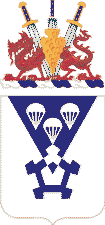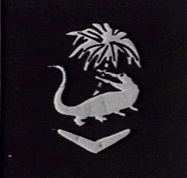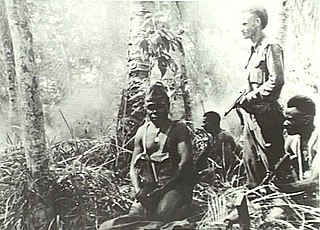
The 33rd Infantry Division was a formation of the U.S. Army National Guard between 1917 and 1968. Originally formed for service during World War I, the division fought along the Western Front at Le Hamel, in the Meuse-Argonne Offensive, on the Somme and around St. Mihiel. It was re-formed in the inter-war years, and then later activated for service during World War II, seeing action against the Japanese in the Pacific. In the post war era, the division was reconstituted as an all-Illinois National Guard division. In the late 1960s, the division was reduced to brigade-sized formation, and is currently perpetuated by the 33rd Infantry Brigade Combat Team.

The Royal Pacific Islands Regiment (RPIR) is an infantry regiment of the Papua New Guinea Defence Force (PNGDF). The regiment is descended from the Australian Army infantry battalions formed from native soldiers and Australian officers and non-commissioned officers in the territories of Papua and New Guinea during World War II to help fight against the Japanese. Disbanded after the war, the regiment was re-raised in 1951 as part of the Australian Army and continued to serve until Papua New Guinea gained its independence in 1975, when it became part of the PNGDF. Today, the RPIR consists of two battalions and has seen active service in Vanuatu, Bougainville and the Solomon Islands.

The 187th Airborne Infantry Regiment (Rakkasans) is a regiment of the 101st Airborne Division. The nickname "Rakkasans" is derived from the Japanese word for parachute. The name was given to the 187th during its tour in occupied Japan following World War II. When a translator dealing with local Japanese dignitaries was trying to explain what their unit was trained to do he used the phrase "parachute-men", or rakkasan. Amused by the clumsy word, the locals began to call the troopers by that nickname; it soon stuck and became a point of pride for the unit.

The 503rd Infantry Regiment, formerly the 503rd Parachute Infantry Regiment and the 503rd Airborne Infantry Regiment, is an airborne infantry regiment of the United States Army. The regiment served as an independent regiment in the Pacific War during World War II; at Fort Campbell, Kentucky; in Okinawa, Japan; and in Germany. Regimental elements have been assigned to the 2nd Infantry Division, the 11th Airborne Division, the 24th Infantry Division, 25th Infantry Division, the 82nd Airborne Division, 101st Airborne Division, and the 173rd Airborne Brigade Combat Team. Regimental elements have participated in campaigns in the Vietnam War, Operation Enduring Freedom–Afghanistan, and Operation Iraqi Freedom. The regiment claims 15 Medal of Honor recipients: two from World War II, 10 from Vietnam, and three from Afghanistan. A parent regiment under the U.S. Army Regimental System. The regiment's 1st and 2nd Battalions are active, assigned to the 173rd Airborne Brigade, based at Caserma Ederle, Vicenza, Italy.

The 4th Armoured Brigade was an armoured formation of the Australian Army established during the Second World War. It was formed in February 1943 to provide armoured support for infantry units operating in the South West Pacific Area. Its composition varied over time, but usually comprised several armoured regiments equipped with Matilda II or M3 Grant tanks as well as some support units.

The 3rd Battalion was an infantry battalion of the Australian Army. Originally raised as part of the First Australian Imperial Force for service during World War I, the battalion formed part of the 1st Brigade, attached to the 1st Division. It was formed shortly after the war broke out and was among the first Australian units to be sent overseas, arriving in Egypt in December 1914. In April 1915 the battalion participated in the Landing at Anzac Cove, coming ashore in the second and third waves. In December 1915 the 3rd Battalion was evacuated from the Gallipoli peninsula and withdrawn to Egypt again, where it took part in the defence of the Suez Canal before being sent to France to fight on the Western Front in March 1916. For the next two and a half years the unit would serve in the trenches in France and Belgium and would take part in many of the major battles fought during that time. In May 1919, following the end of the war, the battalion was disbanded and its personnel repatriated back to Australia.

Merauke Force was an Australian-led military force of World War II which was responsible for defending Merauke in Dutch New Guinea from Japanese attack amidst the Pacific War. The force was established in late 1942 and was disbanded at the end of the war. The Japanese attack did not eventuate and the force never saw combat.
The 34th Infantry Regiment is a Regular Army infantry regiment of the United States Army. It saw combat in World War I, in the Pacific Theater of Operations in World War II, and was the first full American regiment deployed in combat in the Korean War. The 1st and 3rd Battalions of the 34th are now basic training formations attached to the 165th Infantry Brigade at Fort Jackson, South Carolina.

The 1st New Guinea Infantry Battalion was a battalion of the Australian Army during World War II. One of four infantry battalions raised in New Guinea, 1 NGIB was formed in March 1944. In late 1944, the battalion began deploying company-sized elements in support of combat operations on Bougainville, New Britain and on mainland New Guinea. It later became part of the Pacific Islands Regiment before being disbanded in June 1946.

The 2nd New Guinea Infantry Battalion was a battalion of the Australian Army during World War II. One of four infantry battalions raised in New Guinea, 2 NGIB was formed in September 1944. Formed late in the war, the battalion played only a minor role in the Allied campaign in New Guinea, supporting the 6th Division during the final stages of the Aitape–Wewak campaign. In 1945, it became part of the Pacific Islands Regiment, but was disbanded in June 1946.
The 3rd New Guinea Infantry Battalion was a battalion of the Australian Army during World War II. One of four infantry battalions raised in New Guinea, 3 NGIB was formed in June 1945, and spent the remainder of the war training. After becoming operational, it was sent to New Britain where it undertook garrison duties around Rabaul in the post war period. It later became part of the Pacific Islands Regiment before being disbanded in November 1947.
The 4th New Guinea Infantry Battalion (4NGIB) was a battalion of the Australian Army. One of four infantry battalions raised in New Guinea, 4 NGIB was formed in the final stages of World War II. It eventually became part of the Pacific Islands Regiment, but due to the abrupt ending to the war, the battalion did not see action against the Japanese and was disbanded in October 1945 without seeing active service.

The 158th Infantry Regiment ("Bushmasters") is an infantry unit of the Arizona National Guard. The regiment has served abroad in World War I, World War II and Afghanistan.
The 80th Infantry Regiment was an infantry regiment in the Imperial Japanese Army. The regiment was attached to the 40th Infantry Brigade of the 20th Division. The regiment participated during the Second Sino-Japanese War and during the later stages of World War II, the regiment was in New Guinea, as part of the Japanese Eighteenth Army.
The 79th Infantry Regiment was an infantry regiment in the Imperial Japanese Army. The regiment was attached to the 40th Infantry Brigade of the 20th Division. The regiment participated during the Second Sino-Japanese War and during the later stages of World War II, the regiment was in New Guinea, as part of the Japanese Eighteenth Army.
The 102nd Infantry Regiment was an infantry regiment in the Imperial Japanese Army. The regiment was at one stage attached to the 128th Infantry Brigade, of the 114th Division, in the Tenth Army during the Second Sino-Japanese War. The regiment was later attached to the Eastern District Army on 7 September 1940, then the Kwantung Army on 1 August 1941, then assigned to the Twenty-Third Army on 19 September 1941 and the Eighteenth Army in November 1942. The regiment participated during the Second Sino-Japanese War and during the later stages of World War II, the regiment was in New Guinea, taking part in the New Guinea campaign.
The 78th Infantry Regiment was an infantry regiment in the Imperial Japanese Army. The regiment was attached to the 39th Infantry Brigade of the 20th Division. The regiment participated during the Second Sino-Japanese War and during the later stages of World War II, the regiment was in New Guinea, as part of the Japanese Eighteenth Army.
The 115th Infantry Regiment was an infantry regiment in the Imperial Japanese Army. The regiment was attached to the 127th Infantry Brigade of the 114th Division and participated during the Second Sino-Japanese War. It was later reassigned to the 51st Division and during the later stages of World War II, the regiment was in New Guinea, as part of the Japanese Eighteenth Army.
The 66th Infantry Regiment was an infantry regiment in the Imperial Japanese Army. The regiment was attached to the 127th Infantry Brigade of the 114th Division and participated during the Second Sino-Japanese War. It was later reassigned to the 51st Division and during the later stages of World War II, the regiment was in New Guinea, as part of the Japanese Eighteenth Army.

The 42nd Battalion was an infantry battalion of the Australian Army. Raised as part of the Australian Imperial Force (AIF) during the First World War, it was established at Enoggera in December 1915, forming part of the 11th Brigade in the 3rd Division. It subsequently served on the Western Front in France and Belgium in 1916–18 before being disbanded on 22 October 1918. In 1921, the battalion was reformed as part of the Citizens Forces becoming known as the 42nd Battalion. Following the outbreak of the Second World War the battalion held a number of training exercises and camps until 1941, before being mobilised in March 1942 as part of the 29th Brigade, in the 5th Division. It subsequently served in New Guinea fighting against the Japanese during 1943–44 and on Bougainville in 1945, before being disbanded on 7 May 1946. In 1948, it was reformed as part of the re-raised Citizens Military Forces. Today, its lineage is perpetuated by the 31st/42nd Battalion, Royal Queensland Regiment, a unit which continues to serve in the Australian Army Reserve.












